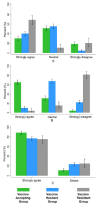Prevalence and Potential Determinants of COVID-19 Vaccine Hesitancy and Resistance in Qatar: Results from a Nationally Representative Survey of Qatari Nationals and Migrants between December 2020 and January 2021
- PMID: 34067103
- PMCID: PMC8151168
- DOI: 10.3390/vaccines9050471
Prevalence and Potential Determinants of COVID-19 Vaccine Hesitancy and Resistance in Qatar: Results from a Nationally Representative Survey of Qatari Nationals and Migrants between December 2020 and January 2021
Abstract
Global COVID-19 pandemic containment necessitates understanding the risk of hesitance or resistance to vaccine uptake in different populations. The Middle East and North Africa currently lack vital representative vaccine hesitancy data. We conducted the first representative national phone survey among the adult population of Qatar, between December 2020 and January 2021, to estimate the prevalence and identify potential determinants of vaccine willingness: acceptance (strongly agree), resistance (strongly disagree), and hesitance (somewhat agree, neutral, somewhat disagree). Bivariate and multinomial logistic regression models estimated associations between willingness groups and fifteen variables. In the total sample, 42.7% (95% CI: 39.5-46.1) were accepting, 45.2% (95% CI: 41.9-48.4) hesitant, and 12.1% (95% CI: 10.1-14.4) resistant. Vaccine resistant compared with hesistant and accepting groups reported no endorsement source will increase vaccine confidence (58.9% vs. 5.6% vs. 0.2%, respectively). Female gender, Arab ethnicity, migrant status/type, and vaccine side-effects concerns were associated with hesitancy and resistance. COVID-19 related bereavement, infection, and quarantine status were not significantly associated with any willingness group. Absence of or lack of concern about contracting the virus was solely associated with resistance. COVID-19 vaccine resistance, hesitance, and side-effects concerns are high in Qatar's population compared with those globally. Urgent public health engagement should focus on women, Qataris (non-migrants), and those of Arab ethnicity.
Keywords: Arab; COVID-19; Middle East and North Africa (MENA); Qatar; hesitancy or refusal; migrant; vaccine willingness.
Conflict of interest statement
P.M.H. reports personal fees from Janssen, Lundbeck, Otsuka, New Bridge Pharmaceuticals and Sunovion, outside the submitted work. All other authors report no conflicts of interest.
Figures


References
-
- WHO Novel Coronavirus—China. Date: 12 January 2020. [(accessed on 21 January 2021)]; Available online: Http://Www.Who.Int/Csr/Don/12-January-2020-Novel-Coronavirus-China/En/
-
- Countries Where Coronavirus Has Spread—Worldometer. [(accessed on 23 January 2021)]; Available online: https://www.worldometers.info/coronavirus/countries-where-coronavirus-ha...
-
- 2020 Impact Report|Saturna Sustainable Funds|Saturna Capital. [(accessed on 24 January 2021)]; Available online: https://www.saturna.com/sustainable/white-papers/2020-impact-report.
-
- Flaxman S., Mishra S., Gandy A., Unwin H.J.T., Coupland H., Mellan T.A., Zhu H., Berah T., Eaton J.W., Guzman P.N.P., et al. Estimating the Number of Infections and the Impact of Non-Pharmaceutical Interventions on COVID-19 in European Countries: Technical Description Update. arXiv. 20202004.11342
-
- Gomes M.G.M., Aguas R., Corder R.M., King J.G., Langwig K.E., Souto-Maior C., Carneiro J., Ferreira M.U., Penha-Gonçalves C. Individual Variation in Susceptibility or Exposure to SARS-CoV-2 Lowers the Herd Immunity Threshold. Epidemiology. 2020 doi: 10.1101/2020.04.27.20081893. preprint. - DOI - PMC - PubMed
Grants and funding
LinkOut - more resources
Full Text Sources
Research Materials

